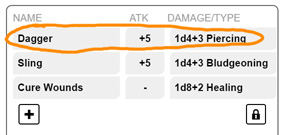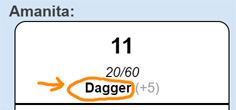Again, it's ok if you don't remember everything the first time around.
Folks will get more familiar with the combat rules after the first couple of kerfuffles.
Normally in D&D, play is rather unstructured. If you would like your character to do something, you can speak up whenever it feels appropriate to do so. And you can describe actions for your character which might take minutes to perform, or even hours.
However combat is performed in fine detail, using 6-second chunks of game time in which everyone involved gets to perform 1 action. When combat begins, the DM establishes an order which the players will perform in. You will have to wait your turn before you can have your character perform an action.
Terminology
Round: The 6-second unit of time used in D&D combat.
Action: The main activity a character performs on his or her turn.
Reaction: A specific action a character is allowed to perform outside of his or her turn in reaction to something.
Opportunity Attack: An attack someone can perform as a reaction to a foe moving out of melee range. That is, if you are standing next to a monster and attempt to move away, it gets a free attack on you. Or if instead the monster tries to move away from you, you would get a free attack on it.
Initiative
When combat begins, the DM will ask everyone to "roll for initiative". This is how we establish what order everyone's turn is in.
When the DM asks for an initiative roll, do the following:
The DM will keep track of the initiative order. Whoever had the highest initiative roll will get to have their turn first. The DM will also make initiative rolls for your foes.
When the DM asks for an initiative roll, do the following:
 At the top center of your character sheet is a box labeled, "Initiative." Click the word, "Initiative".
At the top center of your character sheet is a box labeled, "Initiative." Click the word, "Initiative".(The chat window might complain about no token being selected, ignore that message.) |
||
| Roll a d20, and add to the result the number listed in your sheet's "initiative" box. (This bonus is equal to your Dexterity modifier.) |
The DM will keep track of the initiative order. Whoever had the highest initiative roll will get to have their turn first. The DM will also make initiative rolls for your foes.
Your Turn
Your turn in a combat round consists of a set number of steps, which can be performed in any order.
You can also opt to not use one or more of these steps.
You don't have to use up all of your movement distance if you don't want to.
- You may perform 1 action. See below for a list of possible actions.
- You may move a distance up to your speed in feet.
- You may perform minor flourishes, such as shouting out a sentence and/or interacting with 1 object in the environment.
- You may perform 1 "bonus action", but only if a feature or spell states that it may be performed as a bonus action.
(Not many 1st-level characters even have any bonus actions available to them.)
If multiple bonus actions are available to you, you are still only allowed to use one.
You don't have to use up all of your movement distance if you don't want to.
Actions
On your turn, you may take only one of a number of possible actions. The most common actions are to attack or to cast a spell.
You make one melee or ranged attack. This potentially involves two steps: An attack roll and, if you manage to hit, then a damage roll.
The attack roll:
Based on your attack roll, the DM will tell you if you missed or hit.
(The DM knows this by checking if your roll matches or beats the value of your foe's "armor class".)
The damage roll:
Weilding Two Weapons:
If you don't plan to use two weapons at a time, then of course you don't need to remember this rule.
To wield two weapons, each of them must have the "light" property.
Your first attack is performed as normal, using either one of your weapons. You then have the option of attacking with your other weapon as a bonus action. If this second attack hits, then you do not add your ability modifier to its damage roll, unless that modifier is negative.
If either weapon has the "thrown" property, then you can opt to throw that weapon.
See the "Spell Casting" page for the details on casting spells.
The majority of spells take 1 action to cast.
But one should double check a spell description's "casting time" to make sure. Some spells must be cast as a bonus action, as a longer length of time, or as a reaction.
Using your action to disengage means that your movement will not provoke opportunity attacks for the rest of your turn.
This is handy if you need to flee or otherwise pilot around the battlefield.
Why does the "opportunity attack" rule exist? I suspect it is so that players cannot exploit the system.
For example, imagine that your character were battling the plant monster from "Little Shop of Horrors". Being a plant, it has no movement: it's stuck in place. So without this rule, a character could stand just outside of the plant's reach. On the player's turn, the character could move up to the plant, attack, and then move back out of range. The plant would never be able to defend itself.
Your speed doubles.
For example drinking a magic potion or zapping a wand, if you're ever lucky enough to own these.
If there's anything else you would like your character to do which would use up all of the time in your round, you are free to use your action for that. Lengthy tasks may require dedicating more than one of your turns to them.
For example, perhaps your character would like to pull a rug out from under someone's feet, or attempt to negotiate.
Action: Attack
You make one melee or ranged attack. This potentially involves two steps: An attack roll and, if you manage to hit, then a damage roll.
The attack roll:
 In the "attacks and spellcasting" section of your sheet, click the weapon you want to attack with.
In the "attacks and spellcasting" section of your sheet, click the weapon you want to attack with. |
||
| Roll a d20, and add to the result the number listed under the "ATK" column for your weapon in your sheet's "attacks and spellcasting"
section. (This bonus is equal to an ability modifier, plus your proficiency bonus if you are proficient in that weapon. The ability modifier is Strength for melee weapons, Dexterity for range weapons, and your choice of Strength or Dexterity for weapons with the "finesse" property.) |
Based on your attack roll, the DM will tell you if you missed or hit.
(The DM knows this by checking if your roll matches or beats the value of your foe's "armor class".)
The damage roll:
 In the CHAT WINDOW, where it displayed the results of your attack roll, click the name of the weapon.
In the CHAT WINDOW, where it displayed the results of your attack roll, click the name of the weapon.BTW, what are all those numbers displayed for your attack roll?
|
||
| Roll your weapon's damage dice, and add any modifiers as described for its damage in the "attacks and spellcasting" section of
your sheet. (The bonus is the same ability modifier used in your attack. Note that your proficiency bonus is not added to your damage roll.) In this example, I would roll 1d4+3. If you roll a critical hit on your attack roll (a "natural 20"), then you get to roll all of your damage dice twice, but still only add your ability modifier once. So a critical hit for my example would deal 2d4+3 damage. |
Weilding Two Weapons:
If you don't plan to use two weapons at a time, then of course you don't need to remember this rule.
To wield two weapons, each of them must have the "light" property.
Your first attack is performed as normal, using either one of your weapons. You then have the option of attacking with your other weapon as a bonus action. If this second attack hits, then you do not add your ability modifier to its damage roll, unless that modifier is negative.
If either weapon has the "thrown" property, then you can opt to throw that weapon.
Action: Cast a Spell
See the "Spell Casting" page for the details on casting spells.
The majority of spells take 1 action to cast.
But one should double check a spell description's "casting time" to make sure. Some spells must be cast as a bonus action, as a longer length of time, or as a reaction.
Action: Disengage
Using your action to disengage means that your movement will not provoke opportunity attacks for the rest of your turn.
This is handy if you need to flee or otherwise pilot around the battlefield.
Why does the "opportunity attack" rule exist? I suspect it is so that players cannot exploit the system.
For example, imagine that your character were battling the plant monster from "Little Shop of Horrors". Being a plant, it has no movement: it's stuck in place. So without this rule, a character could stand just outside of the plant's reach. On the player's turn, the character could move up to the plant, attack, and then move back out of range. The plant would never be able to defend itself.
Action: Dash
Your speed doubles.
Action: Use an Object
For example drinking a magic potion or zapping a wand, if you're ever lucky enough to own these.
Action: Player Idea
If there's anything else you would like your character to do which would use up all of the time in your round, you are free to use your action for that. Lengthy tasks may require dedicating more than one of your turns to them.
For example, perhaps your character would like to pull a rug out from under someone's feet, or attempt to negotiate.